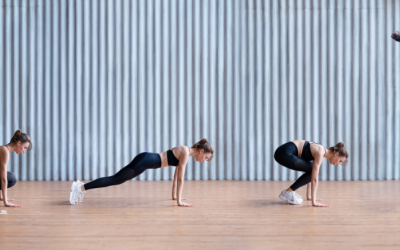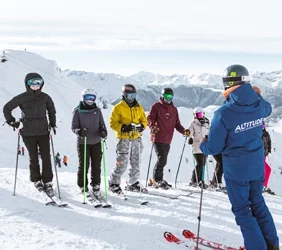Choosing the Best Equipment for Your Ski Instructor Course
Over recent years, we’ve helped hundreds of students earn their ski instructor qualifications. A large part of a trainee’s success comes down to the effort they put into training, combined with the experience and skill of our coaching team.
But just as critical to success is having the right equipment on your ski instructor course. In this blog, we’ll walk you through the essential gear you’ll need for a BASI Level 1 & 2 ski instructor course and how to choose the best setup to set yourself up for success.
Choosing the Right Ski Boots
Our BASI Level 1 & 2 ski instructor course spans 10 weeks, and you’ll be spending long days skiing, training, and shadowing lessons. Because of this, ski boots are arguably the most important piece of equipment you’ll invest in.
A properly fitting, high-performance boot not only determines how comfortable you are but also significantly impacts your ability to perform on the hill.
Why Professional Boot Fitting Matters
We strongly recommend visiting a professional boot fitter. They will assess:
-
Foot size and width
-
Foot shape
-
Biomechanics
-
Any previous injuries
Different brands fit different foot shapes, so your ideal boot may not be the same as your friend’s.
Recommended Flex Rating
The flex of a ski boot determines how much resistance it offers when bending forward. It’s key to finding the right balance between support and mobility.
-
Women: Flex between 90–110
-
Men: Flex between 100–130
⚠️ A higher flex doesn’t always mean better performance. If you have stiffer ankles or limited mobility, a boot with slightly more stiffness can actually help by offering more support and aiding in control.
Key Boot Features
When choosing your boots, look for:
-
Four buckles and a power strap – for secure fit and support
-
Piste-specific design – you won’t need hike mode boots during the course
-
Comfort and adjustability – especially important for long days on snow
Buy in Resort
We work closely with No. 1 Sports, where highly trained boot fitters can help you select the ideal boot once you’re in resort. An Altitude coach can accompany you to ensure the boot fits your needs. Plus, buying in resort allows you to return for adjustments after trying them out on snow.
Coach-Recommended Boots
-
Rossignol Hero
-
Tecnica Firebird
-
Lange RS Wide (great for wider feet)
Choosing the Best Skis for Your Ski Instructor Course
Ski design has evolved rapidly, with skis now tailored to specific disciplines like piste, powder, or touring. As a trainee instructor, it’s essential to have a piste-specific ski to meet the technical requirements of the course and BASI exams.
While we may explore powder or terrain park skiing during training, your primary ski must be a piste ski for the majority of the course.
Why Piste Skis Are Essential
Piste skis:
-
Are easier to engage an edge
-
Help develop clean turns
-
Perform well in short and long radius turns
-
Are better for skiing bumps and demonstrating technique
Recommended Ski Dimensions
Piste skis are typically:
-
70–78 mm underfoot
-
Tip and tail around 110 mm
This shape provides agility, precision, and control.
What Length Should My Skis Be?
We recommend skis that are 5–10 cm shorter than your height. This provides the ideal balance between stability and maneuverability, making it easier to perform accurate movements and control your turn shape.
Understanding Ski Flex
While softer skis are easier to bend, they often lack feedback, which can negatively affect balance and precision. Conversely, skis that are too stiff may:
-
Be hard to steer
-
Require more strength to initiate turns
-
Cause you to “ride” the ski instead of influencing the arc
The right ski should match your strength and skiing level, offering a balance of stability and responsiveness. Brands typically indicate whether a ski is intended for beginner, intermediate, or advanced skiers, which helps guide your decision.
🎿 As a future instructor, you need a ski that allows you to clearly demonstrate the skiing progression to learners. Choosing the right ski is a vital step in becoming a well-rounded and effective coach.
Off-Piste Course Notes
If you’re enrolled in the Off-Piste Course this season, the same ski selection principles apply when preparing for your Level 1 qualification.
Many previous students choose to:
-
Rent off-piste skis from No. 1 Rentals
-
Purchase both piste and off-piste skis if they want a long-term setup
Coach-Recommended Skis
Below are some trusted skis that are well-suited for instructor trainees. Check out our Altitude deals via the provided links:
BASI Level 1 & 2 Ski Instructor Course Recommendations
-
Men’s: Rossignol FORZA 60 V-TI K NX12
-
Women’s: NOVA 14K NX12
These skis are designed to meet the performance and versatility demands of the course, making them a great option for future instructors.
Final Thoughts
Having the right equipment is a foundational part of your training. A ski boot that fits correctly and a piste-specific ski that matches your ability will help you get the most out of your 10-week course. And remember — we’re here to support you every step of the way, from the shop floor to the slopes.
If you’re unsure about anything or want a second opinion, don’t hesitate to ask one of our coaches. We’re always happy to help you find the best gear for your journey.


